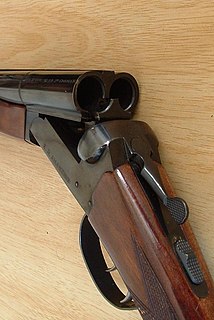 W
WIn firearms terminology, an action is the functional mechanism of a breech-loading firearm that handles the ammunition cartridges, or the method by which that mechanism works. Actions are technically not present on muzzleloaders, as all those are single-shot firearms with a closed off breech with the powder and projectile manually loaded from the muzzle. Instead, the muzzleloader ignition mechanism is referred to as the lock.
 W
WAn automatic firearm is a firearm that continuously chambers and fires rounds when the trigger mechanism is actuated. The action of an automatic firearm is capable of harvesting the excess energy released from a previous discharge to feed a new ammunition round into the chamber, and then ignite the propellant and discharge the projectile by delivering a hammer/striker impact on the primer.
 W
WAn automatic revolver also known as semi-automatic revolver, is a revolver that uses the energy of firing for cocking the hammer and revolving the cylinder, rather than using manual operations to perform these actions. Despite the name "automatic", such revolvers are actually semi-automatic as the gun will not continue shooting and the shooter still needs to manually actuate the trigger to discharge each shot.
 W
WThe Blish lock is a breech locking mechanism designed by John Bell Blish based upon his assumption that under extreme pressures, certain dissimilar metals would resist movement with a force greater than friction laws would predict. In modern engineering terminology, it is an extreme manifestation of what is now called static friction, or stiction. His locking mechanism was used first in the Thompson submachine gun. Nowadays it is discredited as a useful firearm operating principle, due to its almost nonexistent effects on the operation and functioning of a firearm; because of that, firearms which theoretically employed it operate not by the supposed Blish lock principle, but, in fact, by blowback operation.
 W
WBlow-forward is a firearm action where the propellant gas pressure and the friction of the bullet traveling down the bore drag the whole gun barrel forward to facilitate the opening of the breech. This forward barrel motion provides most of the energy required to eject a spent cartridge case and chamber a fresh round of ammunition, and contains a minimum of moving parts and thus more compact than other operating mechanism of equal barrel length.
 W
WBolt action is a type of manual firearm action that is operated by directly manipulating the bolt via a bolt handle, which is most commonly placed on the right-hand side of the weapon.
 W
WThe boxlock action is a hammerless action of a type commonly used in double-barreled shotguns, dating back to 1875. It was developed by Anson and Deeley, based on the earlier Westley Richards action. The boxlock action uses concealed, self-cocking hammers in a break-open action. Strongly opposed at first by most sportsmen and manufacturers, the boxlock action quickly became the dominant form of double-barreled shotgun action.
 W
WBreak action is a type of firearm action in which the barrel or barrels are hinged much like a door and rotate perpendicularly to the bore axis to expose the breech and allow loading and unloading of cartridges. A separate operation may be required for the cocking of a hammer to fire the new round. There are many types of break-action firearms; break actions are universal in double-barrelled shotguns, double rifles and combination guns, and are also common in single shot rifles, pistols, and shotguns, and can also be found in flare guns, grenade launchers, air guns and some older revolver designs. They are also known as hinge-action, break-open, break-barrel, break-top, or, on old revolvers, top-break actions.
 W
WA breechloader is a firearm in which the user loads the ammunition via the rear (breech) end of its barrel, as opposed to a muzzleloader, which loads ammunition via the front (muzzle).
 W
WA breechblock is the part of the firearm action that closes the breech of a breech loading weapon before or at the moment of firing. It seals the breech and contains the pressure generated by the ignited propellant. Retracting the breechblock allows the chamber to be loaded with a cartridge.
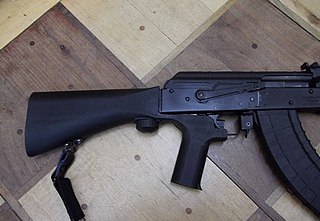 W
WBump stocks or bump fire stocks are gun stocks that can be used to assist in bump firing. Bump firing is the act of using the recoil of a semi-automatic firearm to fire ammunition cartridges in rapid succession, but with a loss of accuracy.
 W
WIn automatic firearms, burst mode or burst-fire is a firing mode enabling the shooter to fire a predetermined number of rounds, usually two or three rounds on hand held weapons and 50-100+ on anti-aircraft weapons and autocannons, with a single pull of the trigger. This firing mode is commonly used in submachine guns and assault rifles. Other types of firearms, such as machine pistols, e.g., the Heckler & Koch VP70 and Beretta 93R also have a burst mode.
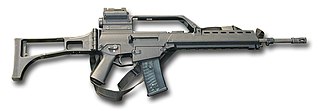 W
WA semi or full-automatic firearm which is said to fire from a closed bolt is one where, when ready to fire, a round is in the chamber and the bolt and working parts are forward. When the trigger is pulled, the firing pin or striker fires the round; the action is cycled by the energy of the shot, sending the bolt to the rear, which extracts and ejects the empty cartridge case; and the bolt goes forward, feeding a fresh round from the magazine into the chamber, ready for the next shot.
 W
WDirect impingement is a type of gas operation for a firearm that directs gas from a fired cartridge indirectly into the bolt carrier or slide assembly to cycle the action. Firearms using direct impingement are theoretically lighter, more accurate, and less expensive than firearms using cleaner and cooler gas piston systems.
 W
WA doglock is a type of lock for firearms that preceded the 'true' flintlock in rifles, muskets, and pistols in the 17th century. Commonly used throughout Europe in the late seventeenth century, it gained popular favor in the British and Dutch military. A doglock carbine was the principal weapon of the harquebusier, the most numerous type of cavalry in the armies of the Thirty Years' War and English Civil War era. Like the snaphance, it was largely supplanted by the flintlock.
 W
WFlintlock is a general term for any firearm that uses a flint striking ignition mechanism. The term may also apply to a particular form of the mechanism itself, also known as the true flintlock, that was introduced in the early 17th century, and gradually replaced earlier firearm-ignition technologies, such as the matchlock, the wheellock, and the earlier flintlock mechanisms.
 W
WThe flintlock mechanism is a type of lock used on muskets, rifles, and pistols from the early 17th to the mid-19th century. It is commonly referred to as a "flintlock", though that term is also commonly used for the weapons themselves as a whole, and not just the lock mechanism.
 W
WGas-operation is a system of operation used to provide energy to operate locked breech, autoloading firearms. In gas-operation, a portion of high-pressure gas from the cartridge being fired is used to power a mechanism to dispose of the spent case and insert a new cartridge into the chamber. Energy from the gas is harnessed through either a port in the barrel or a trap at the muzzle. This high-pressure gas impinges on a surface such as a piston head to provide motion for unlocking of the action, extraction of the spent case, ejection, cocking of the hammer or striker, chambering of a fresh cartridge, and locking of the action.
 W
WA hammerless firearm is a firearm that lacks an exposed hammer or hammer spur. Although it may not literally lack a hammer, it lacks a hammer that the user can pull directly. One of the disadvantages of an exposed hammer spur is the tendency to get caught on items such as clothing; covering the hammer by removing the spur reduces this tendency.
 W
WThe hand cannon, also known as the gonne or handgonne, is the first true firearm and the successor of the fire lance. It is the oldest type of small arms as well as the most mechanically simple form of metal barrel firearms. Unlike matchlock firearms it requires direct manual external ignition through a touch hole without any form of firing mechanism. It may also be considered a forerunner of the handgun. The hand cannon was widely used in China from the 13th century onward and later throughout Eurasia in the 14th century. In 15th century Europe, the hand cannon evolved to become the matchlock arquebus, which became the first firearm to have a trigger.
 W
WA hand ejector is a revolver design that is used on most double-action revolvers to this day.
 W
WA harmonica gun or slide gun is a form of firearm which was breech loaded with a steel slide, containing a number of chambers bored in it and which were filled with projectiles. Most harmonica guns are percussion cap guns, although some designs exist for compressed air guns and some examples were made in pinfire cartridge form. In percussion cap guns, each chamber contains a separate primer, powder charge, and projectile. The slide was inserted in an opening in the breech action and could be advanced by releasing the camlock, moving the slide by hand. The gun comes in both pistol and rifle models, as well as single-action and double-action.
 W
WIn firearms, headspace is the distance measured from a closed chamber's breech face to the chamber feature that limits the insertion depth of a cartridge placed in it. Used as a verb by firearms designers, headspacing refers to the act of stopping deeper cartridge insertion. The exact part of the cartridge that seats against the limiting chamber feature differs among cartridge and gun designs. Bottleneck rifle cartridges headspace on their case shoulders; rimmed cartridges headspace on the forward surfaces of their case rims; belted cartridges headspace on the forward surfaces of their case belts; rimless pistol cartridges headspace on their case mouths.
 W
WThe Kalthoff repeater was a type of repeating firearm that was designed by members of the Kalthoff family around 1630, and became the first repeating firearm to be brought into military service. At least nineteen gunsmiths are known to have made weapons following the Kalthoff design. Some early Kalthoff guns were wheellocks, but the rest were flintlocks. The capacity varied between 5 and 30 rounds, depending on the style of the magazines. A single forward and back movement of the trigger guard, which could be done in 1–2 seconds, readied the weapon for firing. The caliber of Kalthoff guns generally varied between 0.4 and 0.8 inches, though .3 caliber examples also exist.
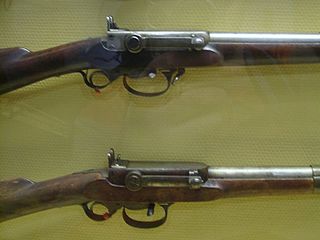 W
WThe Kammerlader, or "chamber loader", was the first Norwegian breech-loading rifle, and among the first breech loaders adopted for use by an armed force anywhere in the world. A single-shot black-powder rifle, the kammerlader was operated with a crank mounted on the side of the receiver. This made it much quicker and easier to load than the weapons previously used. Kammerladers quickly gained a reputation for being fast and accurate rifles, and would have been a deadly weapon against massed ranks of infantry.
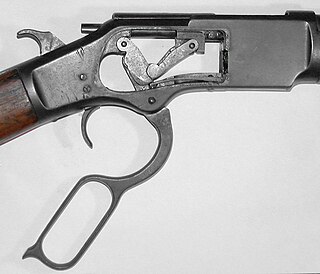 W
WLever action is a type of action for repeating firearms that uses a manually operated cocking handle located around the trigger guard area that pivots forward to move the bolt via internal linkages, which will feed/extract cartridges into/out of the chamber and cock the firing pin mechanism. This contrasts to other type of repeating actions such as the bolt-action, pump-action, semi-automatic or automatic/selective-fire actions. A firearm using this operating mechanism is colloquially referred to as a levergun.
 W
WBelow is the list of blow-forward weapons
 W
WThe lock of a firearm is the mechanism used to initiate firing. From the earliest guns, the propellent charge was lit through a touch hole. In firearms, a flash pan next to the touch hole was filled with a small priming charge. Mechanisms would light the priming charge by touching it with a lit piece of slow match or by creating sparks. Percussion caps replaced loose gun powder as the priming charge. They were fitted over a nipple screwed into the end of the touch hole and ignited by striking with a hammer. With the advent of metallic cartrides, the priming charge was incorporated into the cartridge and would be inside the chamber of the firearm. The percussion cap had to be struck by a firing-pin that passed through the breechblock. The firing-pin would be struck by a hammer or the firing-pin may be an extension of the hammer.
 W
WThe matchlock was the first mechanism invented to facilitate the firing of a hand-held firearm. Before this, firearms had to be fired by applying a lit match to the priming powder in the flash pan by hand; this had to be done carefully, taking most of the soldier's concentration at the moment of firing, or in some cases required a second soldier to fire the weapon while the first held the weapon steady. Adding a matchlock made the firing action simple and reliable by a single soldier, allowing them to keep both hands steadying the gun and eyes on the target while firing.
 W
WMiquelet lock is a modern term used by collectors and curators for a type of firing mechanism used in muskets and pistols. It is a distinctive form of snaplock, originally as a flint-against-steel ignition form, once prevalent in the Ottoman Empire, Italy, Spain, Portugal, North Africa, the Balkans and throughout Spain's colonies from the late 16th to the mid 19th centuries.
 W
WA multiple barrel firearm is any type of firearm with more than one gun barrel, usually to increase the rate of fire or hit probability and to reduce barrel erosion/overheating.
 W
WA firearm is said to fire from an open bolt if, when ready to fire, the bolt and working parts are held to the rear of the receiver, with no round in the chamber. When the trigger is actuated, the bolt travels forward, feeds a cartridge from the magazine or belt into the chamber, and fires that cartridge in the same movement. Like any other self-loading design, the action is cycled by the energy released from the propellant, which sends the bolt back to the rear, compressing the mainspring in readiness for firing the next round. In an open-bolt gun firing semi-automatically, the bolt is caught and held at this point by the sear after each shot; and in automatic open-bolt fire, it's caught and held in this manner whenever the trigger is released. In contrast to this, in closed-bolt guns the trigger and sear doesn't affect the movement of the bolt directly.
 W
WThe Peabody action was an early form of breechloading firearm action, where the heavy breechblock tilted downwards across a bolt mounted in the rear of the breechblock, operated by a lever under the rifle. The Peabody action most often used an external hammer to fire the cartridge.
 W
WThe percussion cap or percussion primer, introduced in the early 1820s, is a type of single-use percussion ignition device for muzzle loader firearm locks enabling them to fire reliably in any weather condition. This crucial invention gave rise to the cap lock mechanism or percussion lock system using percussion caps struck by the hammer to set off the gunpowder charge in percussion guns including percussion rifles and cap and ball firearms. Any firearm using a caplock mechanism is a percussion gun. Any long gun with a cap-lock mechanism and rifled barrel is a percussion rifle. Cap and ball describes cap-lock firearms discharging a single bore-diameter spherical bullet with each shot.
 W
WA repeating firearm, or repeater, is any firearm that is capable of being fired repeatedly before having to manually reload new ammunition into the weapon.
 W
WA revolver is a repeating handgun that has at least one barrel and uses a revolving cylinder containing multiple chambers for firing. Before firing a round, cocking the hammer partially rotates the cylinder, indexing one of the cylinder chambers into alignment with the barrel, allowing the bullet to be fired through the bore. The hammer cocking can be achieved by either the user manually pulling the hammer back, via internal linkage relaying a rearward movement of the trigger, or both. By sequentially rotating through each chamber, the revolver allows the user to fire multiple times until having to reload the gun, unlike older single-shot firearms that had to be reloaded after each shot.
 W
WA revolver cannon is a type of autocannon, commonly used as an aircraft gun. It uses a cylinder with multiple chambers, like those of a revolver handgun, to speed up the loading-firing-ejection cycle. Some examples are also power-driven, to further speed the loading process. Unlike a rotary cannon, a revolver cannon has only a single barrel, thus its spun weight is lower. Automatic revolver cannons have been produced by many different manufacturers.
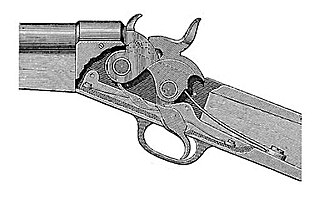 W
WA rolling-block action is a form of firearm action where the sealing of the breech is done with a specially shaped breechblock able to rotate on a pin. The breechblock is shaped like a section of a circle. The breechblock is locked into place by the hammer, thus preventing the cartridge from moving backwards at the moment of firing. By cocking the hammer, the breechblock can be rotated freely to reload the weapon.
 W
WRotating bolt is a method of locking the breech of a firearm closed for firing. Johann Nicolaus von Dreyse developed the first rotating bolt firearm, the "Dreyse needle gun", in 1836. Like the Mauser M 98 or M16, the Dreyse locked using the bolt handle rather than lugs on the bolt head. The first rotating bolt rifle with two lugs on the bolt head was the Lebel Model 1886 rifle. The concept has been implemented on most firearms chambered for high powered cartridges since the 20th century.
 W
WSelective fire means the capability of a weapon to be adjusted to fire in semi-automatic, burst mode, and/or fully automatic firing mode. The modes are chosen by means of a selector switch, which varies depending on the weapon's design. Some selective-fire weapons have burst fire mechanisms to limit the maximum number of shots fired automatically in this mode. The most common limits are two or three rounds per trigger pull. Fully automatic fire refers to the ability for a weapon to fire continuously until either the feeding mechanism is emptied or the trigger is released. Semi-automatic refers to the ability to fire one round per trigger pull.
 W
WA semi-automatic pistol is a type of repeating single-chamber handgun (pistol) that automatically cycles its action to insert the subsequent cartridge into the chamber (self-loading), but requires manual actuation of the trigger to actually discharge the following shot. As a result, only one round of ammunition is fired each time the trigger is pulled, as the pistol's fire control group disconnects the trigger mechanism from the firing pin/striker until the trigger has been released and reset.
 W
WSingle-shot firearms are firearms that hold only a single round of ammunition, and must be reloaded manually after every shot. The history of firearms began with single-shot designs, then multi-barreled designs appeared, and eventually many centuries passed before multi-shot repeater designs became commonplace.
 W
WThe snap matchlock is a type of matchlock mechanism used to ignite early firearms. It was used in Europe from about 1475 to 1640, and in Japan from 1543 until about 1880, and was also largely used by Korea (Joseon) during the Imjin war to the early 20th century.
 W
WA snaphance or snaphaunce is a type of lock for firing a gun or is a gun using that mechanism. The name is Dutch in origin but the mechanism cannot be attributed to the Netherlands with certainty. It is the mechanical progression of the wheellock firing mechanism, and along with the miquelet lock and doglock are predecessors of the flintlock mechanism. It fires from a flint struck against a striker plate above a steel pan to ignite the priming powder which fires the gun. Examples of this firearm can be found through Europe, North Africa, and the Middle East.
 W
WA snaplock is a type of lock for firing a gun or is a gun fired by such a lock.
 W
WA toradar is an Indian matchlock dating from the 16th century. It was a preferred firearm in India well until the mid 19th-century because of its simple and cheap design.
 W
WIn firearms, a trapdoor is a form of breech-loading mechanism for rifles in which a hinged breechblock rotates up and forward, resembling the movement of a trapdoor. The Springfield models 1865 and 1873 were best known for first employing this type of action.
 W
WA volley gun is a gun with multiple single-shot barrels that shoot projectiles in volley fire, either simultaneously or in succession. Although capable of unleashing intense firepower, volley guns differ from modern machine guns in that they lack autoloading and automatic fire mechanisms, and therefore their volume of fire is limited by the number of barrels bundled together.
 W
WThe Welin breech block was a revolutionary stepped, interrupted thread design for locking artillery breeches, invented by Axel Welin in 1889 or 1890. Shortly after, Vickers acquired the British patents. Welin breech blocks provide obturation for artillery pieces which use separate loading bagged charges and projectiles. In this system the projectile is loaded first and then followed by cloth bags of propellant.
 W
WA wheellock, wheel-lock or wheel lock is a friction-wheel mechanism which creates a spark that causes a firearm to fire. It was the next major development in firearms technology after the matchlock and the first self-igniting firearm. Its name is from its rotating steel wheel to provide ignition. Developed in Europe around 1500, it was used alongside the matchlock and was later superseded by the snaplock (1540s), the snaphance (1560s) and the flintlock.